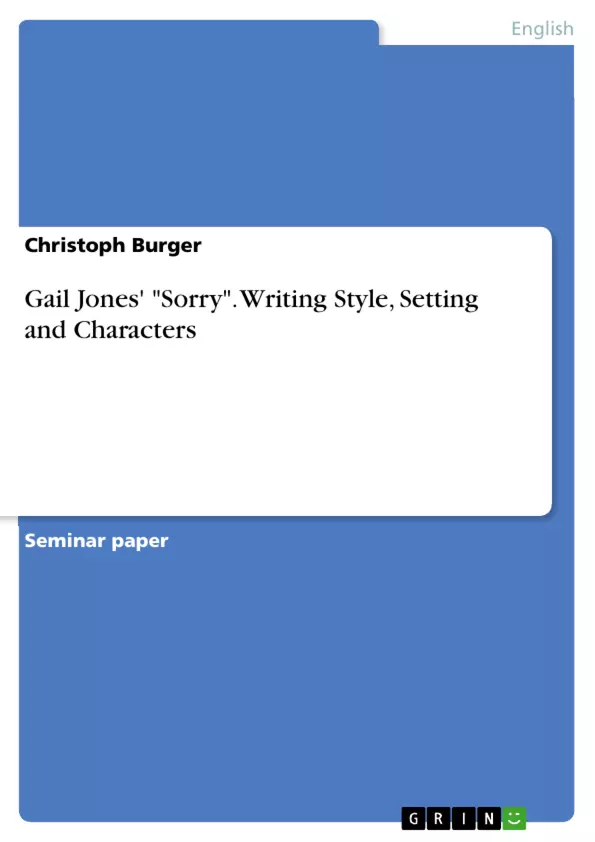The present paper contains reflections about the writing style, setting and main characters of the novel titled "Sorry" by Gail Jones.
Table of Contents
- 1. INTRODUCTION
- 2. STYLE
- 3. SETTING
- 4. MAIN CHARACTERS
- 4.1. PERDITA KEENE
- 4.2. NICHOLAS KEENE
- 4.3. STELLA KEENE
- 4.4. MARY
- 4.5. THE TREVORS
- 4.6. ABORIGINES AND "HALF-CASTES"
- 4.7. TED AND FLORA RAMSAY
- 4.8. DR VICTOR OBLOV
- 5. BIBLIOGRAPHY
- 6. INDEX
Objectives and Key Themes
This seminar paper analyzes the style, setting, and main characters of Gail Jones' novel "Sorry." The objective is to provide a comprehensive overview of these elements and their contribution to the overall narrative.
- Narrative Style and Structure
- Character Development and Relationships
- Setting and its Influence on the Characters
- Themes of Trauma and Memory
- Use of Literary Devices (e.g., flashbacks, foreshadowing)
Chapter Summaries
1. Introduction: This introductory chapter lays the groundwork for the subsequent analysis of Gail Jones' "Sorry." It explains the context of the paper, written as part of a seminar on Australian literature, and clearly states its focus: a detailed examination of the novel's style, setting, and key characters. The introduction sets the stage for a critical exploration, highlighting the chosen aspects for analysis, which will be developed in subsequent chapters.
2. Style: This chapter delves into the stylistic choices employed by Gail Jones in "Sorry." It describes the novel's simple sentence structure contrasted with its unusual vocabulary, leading to a discussion of the challenges presented to the modern reader. The analysis highlights Jones' use of indirect characterization through dialogue, actions, and reactions, providing examples. The non-linear narrative structure, characterized by flashbacks and suspense surrounding a murder, is also explored, emphasizing how the narrative's structure contributes to the overall mystery and the gradual revelation of information. The chapter touches upon the author's use of foreshadowing and flash-forwards and then discusses some experimental aspects, including the inclusion of Shakespearean sonnets and the shifting narrative voice between first and third person perspectives. These choices are analyzed in relation to their impact on the reading experience and their role in character development. The chapter explores different interpretations of this narrative strategy, considering the possibility of both narrative voices representing different facets of the protagonist. The reliability of the narration is also called into question and related to the protagonist's mental state.
Keywords
Gail Jones, Sorry, Australian Literature, Narrative Style, Characterization, Setting, Flashbacks, Foreshadowing, Trauma, Memory, Narrative Voice, unreliable narration, indirect characterization.
Gail Jones' "Sorry": A Comprehensive FAQ
What is this document?
This HTML document provides a structured overview of a seminar paper analyzing Gail Jones' novel, "Sorry." It includes a table of contents, objectives and key themes, chapter summaries, and keywords. The information is intended for academic use and analysis of themes within the novel.
What are the main sections covered in the analysis of "Sorry"?
The analysis focuses on four key areas: the narrative style and structure, character development and relationships, the setting and its influence on the characters, and the overarching themes of trauma and memory. Specific literary devices, such as flashbacks and foreshadowing, are also examined.
What aspects of the novel's style are discussed?
The analysis explores the novel's unique stylistic choices, including its simple sentence structure contrasted with unusual vocabulary, the use of indirect characterization, the non-linear narrative structure with flashbacks, foreshadowing and flash-forwards, the inclusion of Shakespearean sonnets, and the shifting narrative voice between first and third person perspectives. The reliability of the narration and its connection to the protagonist's mental state are also questioned.
Which characters are analyzed in detail?
The analysis delves into the main characters of "Sorry," including Perdita Keene, Nicholas Keene, Stella Keene, Mary, The Trevors, Aborigines and "Half-castes," Ted and Flora Ramsay, and Dr. Victor Oblov. The relationships between these characters are also explored.
How is the setting of the novel analyzed?
The analysis examines the setting of the novel and its impact on the characters and the overall narrative. While specifics aren't detailed here, the significance of the setting is highlighted as a key element of the analysis.
What are the key themes explored in the analysis?
The key themes examined include trauma, memory, and the complexities of relationships within the context of the novel's setting and narrative structure.
What is the objective of this seminar paper?
The objective is to provide a comprehensive overview of the style, setting, and main characters of Gail Jones' "Sorry," and to demonstrate how these elements contribute to the overall narrative and thematic concerns of the novel.
What is included in the chapter summaries?
The document provides summaries for each chapter. The introduction sets the context and focus of the analysis. Chapter 2 details the stylistic choices and their impact. Further chapters would cover additional aspects, although their details are not provided in this preview.
What keywords are associated with this analysis?
Keywords include: Gail Jones, Sorry, Australian Literature, Narrative Style, Characterization, Setting, Flashbacks, Foreshadowing, Trauma, Memory, Narrative Voice, unreliable narration, and indirect characterization.
Where can I find a complete version of this analysis?
This is a preview; the complete seminar paper is not included here. Further details on obtaining the full text would need to be sought from the original source.
- Quote paper
- Christoph Burger (Author), 2013, Gail Jones' "Sorry". Writing Style, Setting and Characters, Munich, GRIN Verlag, https://www.grin.com/document/267882



